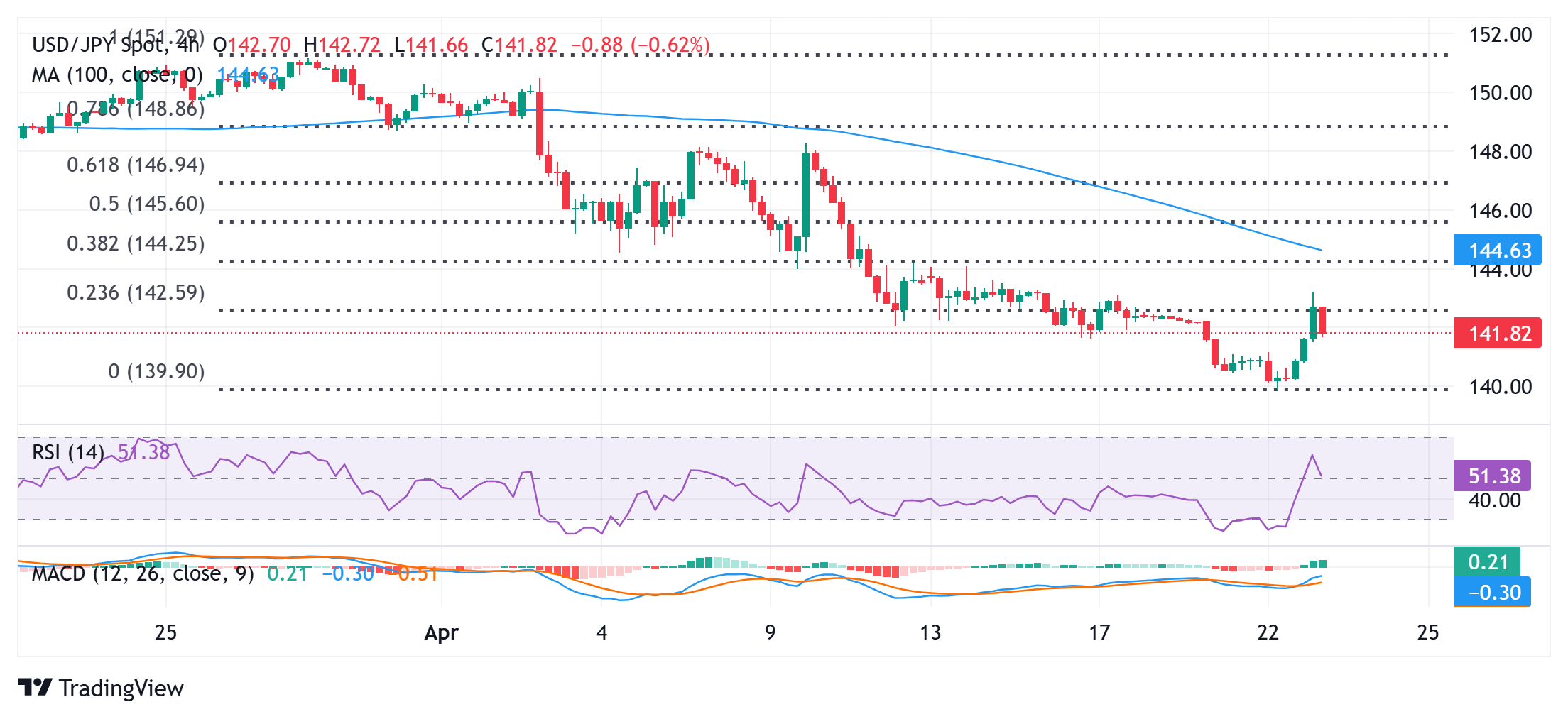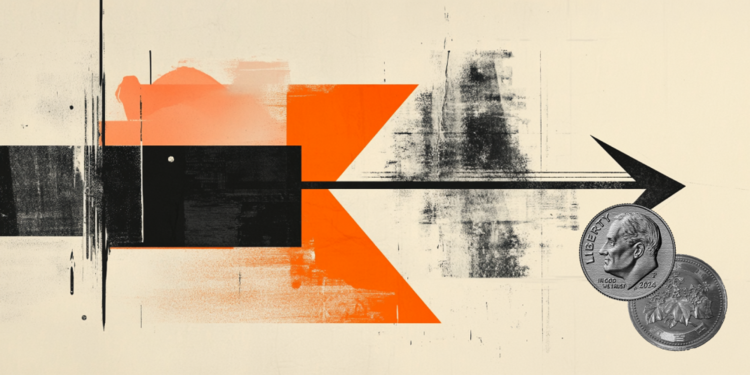- The Japanese Yen attracts some dip-buyers and stalls its pullback from a multi-month low against the USD.
- Hopes for a US-Japan trade deal and rising bets for more BoJ rate hikes in 2025 continue to underpin the JPY.
- A positive turnaround in the global risk sentiment might cap any meaningful gains for the safe-haven JPY.
The Japanese Yen (JPY) drifts lower against its American counterpart for the second successive day on Wednesday and retreats further from a multi-month peak touched the previous day. Upbeat comments from Trump administration officials about US-China trade talks trigger a sharp recovery in the global risk sentiment, which, in turn, weighs heavily on traditional safe-haven assets, including the JPY. Moreover, some follow-through US Dollar (USD) recovery from a multi-year low, bolstered by easing fears about the Federal Reserve’s (Fed) independence, pushed the USD/JPY pair to a one-week high – a level beyond the 143.00 mark during the Asian session.
The growing optimism that the US and Japan are moving closer to an interim arrangement on trade helps the JPY, which reacted little to rather unimpressive domestic PMIs, in stalling the intraday slide. Adding to this, firming expectations that the Bank of Japan (BoJ) will continue raising interest rates in 2025 hold back the JPY bears from placing aggressive bets. Meanwhile, investors have been losing confidence in the US economy on the back of Trump’s rapidly shifting stance on trade policies. This, along with bets that the Fed will resume its rate-cutting cycle soon, caps the Greenback and drags the USD/JPY pair below the 142.00 mark in the last hour.
Japanese Yen bulls turn cautious amid receding safe-haven demand; downside seems cushioned
- The global risk sentiment gets a strong boost after US Treasury Secretary Scott Bessent said at a private investor summit that the tit-for-tat tariff war between the US and China would de-escalate soon. Later, White House spokeswoman Karoline Leavitt told reporters that the Trump administration is setting the stage for a deal. This, in turn, contributes to improving investors’ appetite for riskier assets and driving flows away from perceived safe-haven assets, including the Japanese Yen.
- Meanwhile, US President Donald Trump ruled out the possibility of taking the unprecedented step of firing Federal Reserve Chair Jerome Powell before the expiry of his term in May 2026. This, in turn, triggers a goodish US Dollar recovery from a three-year low, which assists the USD/JPY pair to attract some follow-through buyers during the Asian session on Wednesday. The USD move up, however, runs out of steam amid the prospects for more aggressive policy easing by the Fed.
- According to the CME Group’s FedWatch Tool, traders are pricing in the possibility that the Fed will lower borrowing costs by 25 basis points in June and deliver at least three rate cuts by the end of this year. This marks a big divergence in comparison to a rising consensus that the Bank of Japan will continue hiking interest rates in 2025. Apart from this, the hope that Japan might strike a trade deal with the US helps limit the JPY losses and prompt some intraday selling around the USD/JPY pair.
- In fact, the new US ambassador to Japan said last Friday that he is optimistic about a deal in the ongoing US-Japan tariff negotiations. However, Japan’s Economic Revitalization Minister Ryosei Akazawa said that any agreement would likely take some time as it’s difficult to say how long it will take to bridge the gap between the two sides. This might keep a lid on any optimism in the market and warrants some caution before placing aggressive bullish bets around the USD/JPY pair.
- Meanwhile, the preliminary Purchasing Managers’ Index (PMI) released earlier this Wednesday showed that Japanese manufacturing activity has shrunk for the tenth consecutive month in April. The au Jibun Bank manufacturing PMI came in at 48.5 in April, slightly higher compared to 48.4 in the previous month. In contrast, Japanese services activity rebounded and the au Jibun Bank Services PMI rose to 52.2 during the reported month compared to a neutral reading of 50.0 in March.
- Wednesday’s economic docket also features the release of flash global PMIs, which might provide a fresh insight into the global economic health. Apart from this, trade-related developments would play a key role in influencing the broader market risk sentiment and driving demand for the safe-haven JPY.
USD/JPY struggles to find acceptance above the 143.00 mark or the 23.6% Fibo. level

From a technical perspective, the USD/JPY pair showed some resilience below the 140.00 psychological mark on Tuesday and the subsequent short-covering rally warrants some caution for bearish traders. The recovery momentum, however, struggles to find acceptance above the 143.00 mark or the 23.6% Fibonacci retracement level of the March-April downfall. This, in turn, should now act as a key pivotal point, above which spot prices might aim to surpass the Asian session peak, around the 143.20 area, and climb further towards reclaiming the 144.00 mark. The momentum could extend further towards the 144.25-144.30 region or the 38.2% Fibo. level.
On the flip side, weakness below the 141.45 zone, or the Asian session low, now seems to find decent support near the 141.00 mark. A convincing break below the latter, however, will suggest that the recent downtrend is still far from being over and make the USD/JPY pair vulnerable to retesting sub-140.00 levels, with some intermediate support near the 140.45 region. The subsequent downfall would expose the 2024 swing low, around the 139.60-139.55 area.
Japanese Yen FAQs
The Japanese Yen (JPY) is one of the world’s most traded currencies. Its value is broadly determined by the performance of the Japanese economy, but more specifically by the Bank of Japan’s policy, the differential between Japanese and US bond yields, or risk sentiment among traders, among other factors.
One of the Bank of Japan’s mandates is currency control, so its moves are key for the Yen. The BoJ has directly intervened in currency markets sometimes, generally to lower the value of the Yen, although it refrains from doing it often due to political concerns of its main trading partners. The BoJ ultra-loose monetary policy between 2013 and 2024 caused the Yen to depreciate against its main currency peers due to an increasing policy divergence between the Bank of Japan and other main central banks. More recently, the gradually unwinding of this ultra-loose policy has given some support to the Yen.
Over the last decade, the BoJ’s stance of sticking to ultra-loose monetary policy has led to a widening policy divergence with other central banks, particularly with the US Federal Reserve. This supported a widening of the differential between the 10-year US and Japanese bonds, which favored the US Dollar against the Japanese Yen. The BoJ decision in 2024 to gradually abandon the ultra-loose policy, coupled with interest-rate cuts in other major central banks, is narrowing this differential.
The Japanese Yen is often seen as a safe-haven investment. This means that in times of market stress, investors are more likely to put their money in the Japanese currency due to its supposed reliability and stability. Turbulent times are likely to strengthen the Yen’s value against other currencies seen as more risky to invest in.

